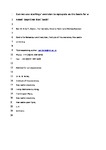Can we use starlings' aversion to eyespots as the basis for a novel 'cognitive bias' task?
| dc.contributor.author | Brilot, BO | en |
| dc.contributor.author | Normandale, CL | en |
| dc.contributor.author | Parkin, A | en |
| dc.contributor.author | Bateson, M | en |
| dc.date.accessioned | 2014-05-15T10:48:48Z | |
| dc.date.available | 2014-05-15T10:48:48Z | |
| dc.date.issued | 2009-05-01 | en |
| dc.identifier.issn | 0168-1591 | en |
| dc.identifier.uri | http://hdl.handle.net/10026.1/3023 | |
| dc.description.abstract |
Experiments in humans have shown that changes in emotional (affective) state cause adaptive changes in the processing of incoming information, termed "cognitive bias". For instance, the states of anxiety and depression have been shown to be associated with "pessimistic" judgements of ambiguous stimuli intermediate between stimuli associated with positive and negative outcomes. This phenomenon provides a promising method for objectively assessing animal emotional states and has been successfully demonstrated in preliminary studies. However, the experiments yielding these results required extensive training to establish the necessary positive and negative associations. Here we present an experiment using responses to eyespot stimuli that are naturally aversive to many bird species, and require no explicit associative training. We manipulated the state of wild-caught European starlings (Sturnus vulgaris) by playing one of four possible sounds: starling "threat call" (control manipulation), a sparrowhawk call (i.e. predator), starling alarm call or white noise, on the assumption that the latter three sounds would cause anxiety. Immediately following the auditory stimulus, we recorded the birds' behaviour in the presence of each of three visual stimuli: eyespots, ambiguous eyespots or no eyespots. We hypothesised that there would be an interaction between the state of the birds and their response to eyespots, with birds showing enhanced aversion to ambiguous eyespots when anxious. We found evidence that white noise and alarm calls generated anxiety, and that eyespots were aversive. However, there was no interaction between state and response to eyespots. In an attempt to understand our failure to obtain the predicted cognitive bias, we discuss evidence that the aversive nature of eyespots is not attributable to predator mimicry, and is therefore not modulated by anxiety. © 2009 Elsevier B.V. All rights reserved. | en |
| dc.format.extent | 182 - 190 | en |
| dc.language.iso | en | en |
| dc.title | Can we use starlings' aversion to eyespots as the basis for a novel 'cognitive bias' task? | en |
| dc.type | Journal Article | |
| plymouth.issue | 3-4 | en |
| plymouth.volume | 118 | en |
| plymouth.publication-status | Published | en |
| plymouth.journal | Applied Animal Behaviour Science | en |
| dc.identifier.doi | 10.1016/j.applanim.2009.02.015 | en |
| plymouth.organisational-group | /Plymouth | |
| plymouth.organisational-group | /Plymouth/Faculty of Science and Engineering | |
| plymouth.organisational-group | /Plymouth/REF 2021 Researchers by UoA | |
| plymouth.organisational-group | /Plymouth/REF 2021 Researchers by UoA/UoA04 Psychology, Psychiatry and Neuroscience | |
| dc.rights.embargoperiod | Not known | en |
| rioxxterms.versionofrecord | 10.1016/j.applanim.2009.02.015 | en |
| rioxxterms.licenseref.uri | http://www.rioxx.net/licenses/all-rights-reserved | en |
| rioxxterms.type | Journal Article/Review | en |


